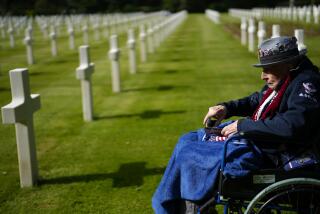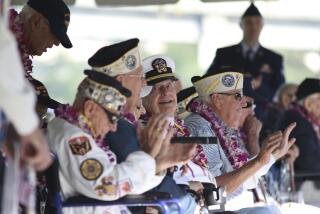New Exhibit Puts Human Face on...
WASHINGTON â Navy Fireman Wes Heidt lost his life the day World War II came to America, while Army Technician Donald Cortwright was on the scene at warâs end. The personal stories of these men and many others make the humanity--and inhumanity--of war real in a new National Archives exhibit.
âI am safer here on this battleboat than I would be driving back and forth to work if I was home,â Wesley John Heidt reassured his mother in Los Angeles in one of the first letters to greet exhibit visitors.
That âbattleboatâ was the USS Arizona, stationed at Pearl Harbor. A few yards from Heidtâs letter is a telegram from the War Department to his mother, informing her that two of her sons--Wesley and Edward--died in battle Dec. 7, 1941. That was the day Japan bombed Pearl Harbor without declaring war, sinking the Arizona and four other battleships and killing 2,300 people. In all, 19 ships were damaged or sunk.
Cortwright, of Coldwater, Mich., was stunned when his unit arrived in Hiroshima two months after the atomic bombing there.
âMy God. Oh my God! Iâll never forget that sight as long as I shall live. . . . Everywhere was the most horrible, terrifying, complete devastation that you can imagine. You canât imagine it,â he wrote his family Oct. 23, 1945.
The exhibit, which opened this month, âlets the parties in the war tell their own story,â said curator Chris Rudy Smith of the Archives. âIt increases the drama, because they did not know how it was going to turn out.â
Between Heidt and Cortwright there are scores of personal letters from big shots and everyday people, highlighted with helmets and rifles, canteens and medals, flags and maps and photos.
Thereâs a copy of President Franklin D. Rooseveltâs speech to Congress the day after the Pearl Harbor attack, with a correction in his own writing to insert the phrase, âa date which will live in infamy.â It was originally written, âa date which will live in world history.â
There are also letters from such other famous folk as field marshals Erwin Rommel and Bernard Montgomery, British Prime Minister Winston Churchill and Brig. Gen. J. H. (Jimmy) Doolittle.
But itâs the diaries, letters and mementos of the soldiers and sailors and Marines fighting the battles that bring life to the exhibit designed by Gary A. Yarrington of the Lyndon B. Johnson Library in Austin, Tex.
Yarrington appealed for letters in veteransâ and retireesâ magazines starting in 1989, and some 900 letters poured in. âItâs human drama, itâs real, itâs what happened,â he said.
âOur force entered Pearl to witness a ghastly sight of sunken ships--oil-covered water--wreckage and ruins,â Navy Radioman Raymond M. Tufteland wrote his family in Lemon Grove, Calif., a few days after the attack.
A distant fatherâs concern for his little daughter comes through in a Sept. 19, 1941, letter from Army Major George S. Fisher of Plumville, Pa., who was stationed in the Philippines.
âI miss you very much. Letâs pretend tonight that Iâm there to get a good-night hug and kiss from you. Remember me in your prayers,â he wrote. Next to that letter is the telegram announcing his death in battle, dated March 25, 1942.
From the fighting in Italy comes a tale of valor in a letter from Army Lt. Randall Harris of Pocahontas, Iowa, who took over command of his company even though he was wounded by the same mine that killed his commanding officer.
âWe continued on to our objective with me leading, a pistol in one hand and my other hand holding my guts. I kept thinking that if I was hit very bad I would feel my shoes fill up with blood . . . ,â he wrote a friend after a landing in the Gulf of Sicily on Dec. 15, 1943. He was later treated for wounds in both legs, shoulders and abdomen.
More to Read
Sign up for The Wild
Weâll help you find the best places to hike, bike and run, as well as the perfect silent spots for meditation and yoga.
You may occasionally receive promotional content from the Los Angeles Times.






